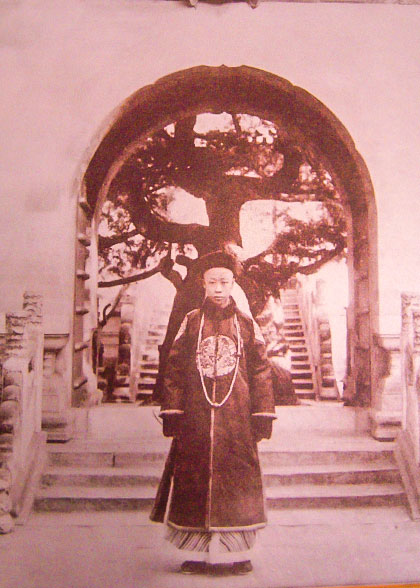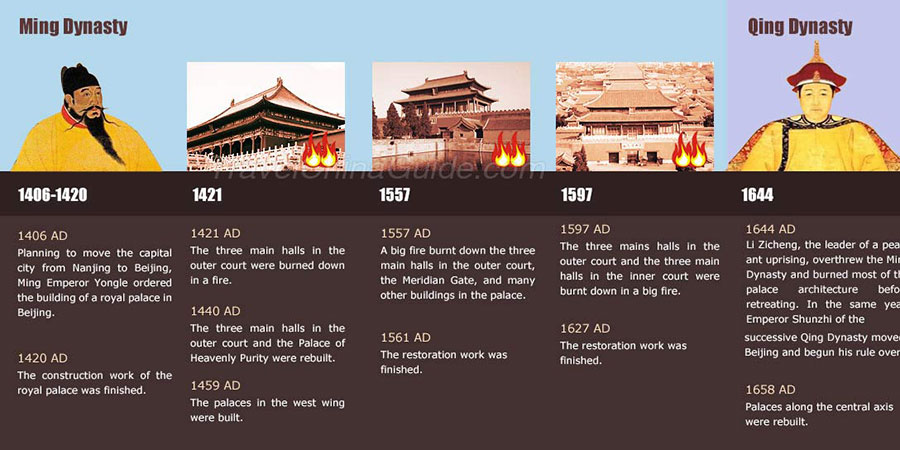Forbidden City History
The history of the Forbidden City dates back to 1406 when Emperor Yongle of the Ming Dynasty decided to build an imperial palace in Beijing, modeled after the one in Nanjing. Fourteen years later, the construction of the magnificent palace was finished. It functioned as the political center of China for over 500 years until the Qing Dynasty was overthrown in 1911. Later in 1925, the Forbidden City was transformed into the Palace Museum to display traditional Chinese architecture, rare treasures and curiosities. In 1987, it was declared a World Cultural Heritage Site by UNESCO.
Construction from 1406 to 1420
Upon ascending the throne, Ming Emperor Yongle decided to move the capital city from Nanjing to Beijing and ordered the construction of an imperial palace, which was called the Forbidden City, in central Beijing. The palace was designed by the great architect Kuai Xiang. More than 230 thousand artisans and millions of laborers participated in the construction. In1420, the splendid imperial palace was completed and Emperor Yongle moved in. Ever since then the Forbidden City functioned as the political center of the Ming Dynasty. Thirteen succeeding emperors of the Ming Dynasty also worked and dwelled there with their royal families.
![]() See more
See more
When was the Forbidden City built?
Why was the Forbidden City built?
Taken Over by the Qing Dynasty
Damage and Restoration
 |
| Puyi - the Last Emperor ever Lived in Forbidden City |
Before the retreat, Li Zicheng burned down most of the palaces and halls in the Forbidden City. After moving into the imperial city, Emperor Shunzhi of the Qing Dynasty spent fourteen years renovating the major buildings along the central axis. Other damaged buildings were rebuilt and restored from 1683 to 1695. More importantly, Emperor Qianlong made some alterations and enlargements during his reign from 1735 to 1796, returning the Forbidden City to its previous scale.
Opened to the Public as a Palace Museum
Removal of the Cultural Relics during War Time
Current Protection and Renovation
 |
| Timeline of Forbidden City History (Click to enlarge) |
Timeline of Forbidden City
| Time | Events |
|---|---|
| 1406 | The construction of the imperial palace begins |
| 1420 | The construction of the imperial palace is finished. |
| 1421 | The three main halls in the outer court are burned down in a fire. |
| 1440 | The three main halls and the Palace of Heavenly Purity are restored. |
| 1459 | The palaces along the west wing are built. |
| 1557 | The three main halls in the outer court, the Meridian Gate, and other buildings are burnt down in a fire. The renovation lasts four years until 1561. |
| 1597 | The three mains halls in the outer court and the three main halls in the inner court are burnt down in a big fire. The restoration lasts thirty years until 1627. |
| 1644 | Li Zicheng occupies the imperial palace, and the Ming Dynasty ends. Li burns most of the buildings in the imperial city before retreat. Emperor Shunzhi of succeeding Qing Dynasty move the capital city from Shenyang to Beijing. Emperor Shunzhi rebuild the buildings along the central axis during the next fourteen years. |
| 1683 | The restoration of other buildings starts and lasts twelve years until 1695. |
| 1735 | Emperor Qianlong ascend the throne. He enlarges and alters the imperial city during his reign from 1735 to 1796. |
| 1813 | The Forbidden City is attacked during a peasant uprising led by Lin Qing. |
| 1900 | Beijing is controlled by the Eight-Nation Alliance Forces. They hold a military review in Forbidden City. |
| 1911 | The Qing Dynasty ends with the breakout of the Revolution of 1911. Emperor Puyi is no longer emperor but still allowed to dwell in the inner court of the imperial palace. |
| 1923 | A great fire breaks out in the Palace of Establishing Happiness (Jianfugong). |
| 1924 | Emperor Puyi is driven out of the imperial palace in a coup. |
| 1925 | The imperial city is transformed into the Palace Museum. |
| 1933 | A large number of cultural relics in the palace are moved to south China for better protection after the Sino-Japanese war breaks out. |
| 1948 | About three thousand boxes of the cultural relics are transported to Taiwan during Civil War. |
| 1949 | The Palace Museum is reopened to the public after the war. |
| In the 1950s and 1960s | Renovation of the museum is put forward by many people, but laid aside for various reasons. |
| 1961 | The Palace Museum is listed in the first group of the key historical and cultural relics under state protection. |
| 1987 | The Palace Museum is declared a World Cultural Heritage Site by UNESCO. |
| 2002 | A large-scale restoration of the museum is begun, and will last until 2021. |
Further Reading: Forbidden City Facts